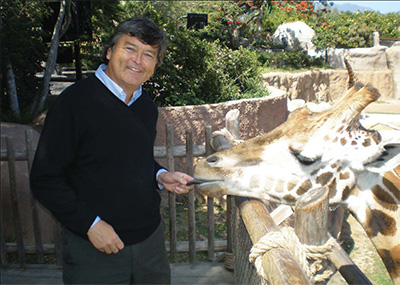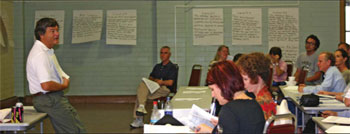
The first and final assessment question for students enrolled in California State University Channel Islands’ Zoo Class is the same: List all the different career opportunities that might be available at the zoo.
Dennis Muraoka can predict the answers he’ll see the first time around.
“Zookeeper…veterinarian…when the average person thinks about a zoo, they don’t think of it as more than just animals and exhibits,” explained Muraoka, professor in the Martin V. Smith School of Business & Economics and special assistant to the President for Institutional Effectiveness.
So why a class that centers on a zoo—in this case the Santa Barbara Zoo—that doesn’t have a focus on the animal sciences, but rather on business, economics, education, and some biology?
Answer: the Zoo Class is a CSUCI original, and its syllabus is a testament to interdisciplinary education—which is a cornerstone at this University. And, there is another aspect of the Zoo Class that makes it unique: its origin.
Muraoka came to CSUCI in 2001 as one of the original 13 faculty members recruited by University President Richard Rush. Muraoka was a professor of economics at CSU Long Beach having spent 19 years at that campus. He came to CSUCI knowing there was an opportunity to create something special and build a new program.
“It was the next stage of my career,” he said about embracing the opportunity to come to the newest campus in the CSU system. “It was like going back to school again.”

"In reality, zoos are like small cities and are much more than just animals in enclosures."
Dennis Muraoka - Professor, Martin V. Smith School of Business & Economics
And then, in 2002, Muraoka did just that.
He learned about a class one of his colleagues in the Art Program had developed called “The Museum.” Muraoka asked Irina Costache, professor of art and creator of the course, if he could attend a few of the classes, which at the time were held at the J. Paul Getty Museum. She welcomed his interest. He said he was fascinated by the numerous tasks that go into commissioning art exhibits and displays at the museum that are invisible to the public eye.
At the same time, Muraoka’s wife, Mimi, had decided to become a docent at the Santa Barbara Zoo, and she began taking the necessary training courses. Muraoka said that his wife was surprised that the focus of her training program was the thematic interpretation of the exhibits rather than animal and exhibit facts.
Soon Muraoka and his CSUCI colleagues in business, economics, education and biology formed a partnership with the Santa Barbara Zoo and the curriculum for the Zoo Class was created. It involved input from people whose careers make up all that is the zoo: education specialists, conservation specialists, retail and restaurant management, public safety, marketing, communications, the chief executive officer, animal husbandry, veterinary care and more.
“In reality, zoos are like small cities and are much more than just animals in enclosures,” he said.
The Zoo Class shows students how people with an array of talents and a common interest can get together and seamlessly run an organization or business, and it also teaches students that if they are passionate about something there’s often a way to bond that passion with a career. “Students often give up too early on careers with ties to fields that they are passionate about,” Muraoka explained. “Let’s look at the big picture and maybe we can figure out a way to keep your hand in the things you love.”
Jamie Kisacky, a 2005 CSUCI graduate and a Zoo Class alumna, said for her, one of the key aspects of the course was meeting the different members of the zoo personnel and learning how each of their roles played a part in the zoo.
“There are many things that I have taken from the Zoo Class that I use in my present career,” explained Kisacky, who works for a company that manufactures parking management equipment. “In my line of work there are many projects that require different departments to work together to complete these projects, and you need to have an understanding of the big picture—like we learned in the Zoo Class—and where it will take the company.”

The Zoo Class is notorious and held in high regard among students, but it’s the contributions Muraoka has made that won’t be found in the course catalog that are helping CSUCI gain notoriety in the academic world.
In 2003, President Rush asked Muraoka to chair the University’s WASC Committee. WASC is an acronym for Western Association of Schools and Colleges and it is the accrediting body for institutions of higher learning in the western region of the United States.
Since his appointment, Muraoka has worked with the entire campus community to generate the reports and assessments necessary for the University to earn WASC accreditation, and in March of this year, CSUCI hosted a site visit for officials from WASC as one of the final elements of the accreditation process. Part of that visit was a poster session (see story on page 2) that was a visual showcase of the different components—from Academic Affairs to Parking Services—that come together to make CSUCI the institution it has become.
The poster session was called the President’s Annual Celebration of Excellence and was Muraoka’s brainchild. He said that he wanted to create something that could display all that he had seen as he worked with the various campus divisions through the accreditation process.
“We had hoped for between 50 to 60 posters, but then seeing 100 on the day of the event and each one had incredible depth, that was powerful,” Muraoka said.
In the fall, Muraoka will again coteach the Zoo Class with his colleague, Professor Alex McNeil, but before getting back to the Santa Barbara Zoo, there are a few other zoos to visit on the Muraokas’ list. This summer Muraoka and his wife will visit the zoos in the Chicago area as well as the zoos in the state of Ohio. They have visited between nearly 40 zoos nationwide and aspire to one day visit all of the 200 accredited zoos and aquariums in the United States.
“Really, when you look at it, I have the best job around here,” he said.
